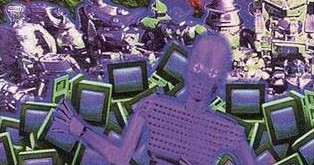by Frisco Del Rosario
Socket to me
Viral Pipeline was the cornerstone of two undefeated
constructed runner decks at the Northwest NetRunner Championship
held April 19 in Springfield, Oregon. Hometown hero Dennis Duncan
won the event with a remarkable Clown-and-Pipeline deck, and visitor
Jim McCoy borrowed a Loan from Chiba-powered Pipeline deck for
the occasion. (The first-place trophy was awarded by combining
scores from the constructed and sealed deck events -- Duncan scored
4-0 in constructed, and 1.5-1.5 in sealed, and I achieved 2.5-1.5
in constructed, and 3-0 in sealed. The tiebreaks favored me.)
The superpowered Viral Pipeline is clearly the
most lethal virus program the runner has at his disposal. After
each successful run on the archives, headquarters, or research
and development, a "socket" counter is placed on that data fort.
When one socket counter has been placed on all three central forts,
the "pipeline" is complete, and the corporation must forgo one
action during its turn.
That is brutal. The Crumble virus trashes normally
untrashable cards, and Taxman grinds away at the corporation's
bit pool, but cards and bits can be recovered. Actions -- the
basic unit of NetRunner movement -- are priceless. Even the richest
corporation with a headquarters full of perfect cards will collapse
if it has no actions.
Viral Pipeline is different from all other virus
programs in that it requires successful runs on three different
forts. Many virus attacks which concentrate on HQ or RD employ
Restrictive Net Zoning in order to weaken the target fort, but
Viral Pipeline plans cannot reasonably restrict all three central
forts. Therefore, a Pipeline scheme requires an effective bit
engine and a strong icebreaker suite. The Pipeline decks which
won four games at the Northwest NetRunner Championships took two
different approaches.
Dennis Duncan's runner deck requires zero bits
to win. Zero bits. The deck relies on Jack 'n' Joe plus
ValuPak Software Bundle to install several daemons, Zetatech Software
Installers, Clowns, and icebreakers with the ability to break
subroutines for zero bits. When the tableau is complete, Duncan
needs just to run three times -- once on each central fort --
to lay down nine Socket counters, leaving the corporation with
zero actions per turn.
Programs
8 Zetatech Software Installer
5 Afreet
5 Clown
3 Viral Pipeline
2 Joan of Arc
2 Succubus
1 Emergency Self-Construct
1 Forward's Legacy
1 Imp
1 Wizard's Book
1 Wrecking Ball
Preps
12 Jack 'n' Joe
7 ValuPak Software Bundle
1 MIT West Tier
That's all, readers -- 30 programs and 20 preps
in the most remarkable architecture I've ever seen. Can it be
beaten? Perhaps. Crystal Palace Station Grid forces the runner
to pay one extra bit to break each subroutine on its fort, and
Duncan's deck, remember, has no income plan. It's also possible
to strengthen ice with Antiquated Interface Routines or Security
Net Optimization to the point where the runner has to pay to pump
the corresponding icebreaker.
City Surveillance must be the corporation's best
answer to this deck, but the part of me which likes absurd humor
wants to install three Chimeras on a central fort.
While Dennis Duncan's Pipeline deck depends on
Clowns to ensure successful runs to give sockets, David Liu fuels
Bartmoss Memorial Icebreaker with Loan from Chiba.
Programs
1 Bartmoss Memorial Icebreaker
1 Joan of Arc
1 Viral Pipeline
Preps
7 Bodyweight Synthetic Blood
2 Pirate Broadcast
2 Inside Job
Resources
11 Loan from Chiba
4 Code Viral Cache
3 Time to Collect
3 Airport Locker
2 Fall Guy
2 Junkyard BBS
Hardware
4 Millitech MRAM Chip
2 The Deck
Duncan's deck drops three Socket counters per action
by having three Viral Pipelines installed. Liu's deck has just
one Pipeline in play, but Pirate Broadcast demands a run on each
fort, and smacks the corporation with three Sockets per action
that way.
Liu's scheme typically starts running several turns
before Duncan's does, sometimes doing an Inside Job on HQ on turn
one or two in order to install Code Viral Cache. Because this
deck gets off to an earlier start and has a dozen Loans
from Chiba to protect, it needs tag protection and base link.
It's a very different approach, but there are some
similarities. City Surveillance is the bete noire of any
Synthetic Blood-sucking runner deck, and strong ice is a deterrent,
too. Of course, it's a lot easier to find ice stronger than Bartmoss
than it is to hamper a Forward's Legacy bolstered by five Clowns,
but Loan from Chiba is one hell of an equalizer.
I don't know what you plan to do about these mighty
Viral Pipeline decks. The corporation can't hope to gain actions
to burn with a huge Project Venice because the runners prepare
themselves rapidly -- Liu's deck takes about nine turns to win,
Duncan's sometimes takes fewer. Corporate Boon? Pacifica Regional
AI?

